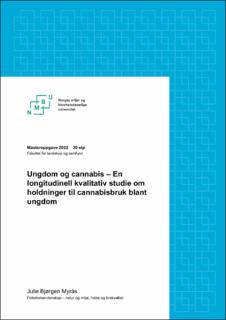| dc.contributor.advisor | Bilgrei, Ola Røed | |
| dc.contributor.advisor | Pedersen, Ingeborg Amalie | |
| dc.contributor.author | Myrås, Julie Bjørgen | |
| dc.coverage.spatial | Norway | en_US |
| dc.date.accessioned | 2022-08-19T12:33:02Z | |
| dc.date.available | 2022-08-19T12:33:02Z | |
| dc.date.issued | 2022 | |
| dc.identifier.uri | https://hdl.handle.net/11250/3012711 | |
| dc.description.abstract | Bakgrunn: Cannabis er det mest utbredte illegale rusmiddelet i bruk blant ungdom i Norge. Tidlig oppstart med cannabis er assosiert med flere negative helsekonsekvenser og sammen med en observert økning i styrkegraden i dagens cannabis, er dette av bekymring for folkehelsen. Ungdomstiden er en fase hvor grunnleggende holdninger formes og utvikles, der risikoatferd som utprøving av rusmidler ikke er uvanlig. Det blir vist til flere faktorer som kan påvirke til cannabisbruk blant ungdom.
Formål: Studiens formål er å undersøke hvilke holdninger dagens ungdom i Norge har til cannabis, og hvordan disse holdningene eventuelt endrer seg fra 10. klasse på ungdomsskolen (tidspunkt ungdomsskole – TU) til 3. trinn på videregående skole (tidspunkt videregående - TV). Fremgangsmåten for å undersøke ungdommens holdninger er å identifisere de faktorer som kan påvirke holdningene. Studiens problemstilling er dermed: Hva påvirker holdningene ungdom har til bruk av cannabis, og endres holdningene fra ungdomsskolen til videregående skole?
Metode: Studien har tatt i bruk kvalitativ metode, med empiri bestående av semistrukturerte individuelle intervjuer. Empirien er blitt samlet inn med en longitudinell tilnærming, med intervjuer ved to tidspunkt med de samme deltakerne. For å analysere datamaterialet ble tematisk analyse brukt innledningsvis, før det ble brukt en longitudinell analyse for å se på eventuelle forandringer og utvikling innenfor hvert tema funnet i den tematiske analysen.
Resultater: Analysen førte til fem hovedtema som bidrar til å besvare problemstillingen: «Aksept til bruk», «Konsekvenser ved bruk», «Påvirkning fra miljøet», «Cannabisrusen» og «Identitet». Det ble i varierende grad observert en utvikling innenfor hvert av temaene, og gjennomgående var det noen forskjeller i holdninger blant de som selv hadde erfaring med cannabis versus de uten erfaring.
Konklusjon: Det ses en utvikling fra TU til TV mot en økt aksept for bruk av cannabis sammen med en opplevelse av at det ikke er et så farlig rusmiddel. Dette viste seg både hos ungdommene med og uten egen erfaring med cannabis. Resultatene var likevel ikke ensbetydende med en økt aksept for cannabis, og det ble også vist til at holdningene til cannabis var varierende blant ungdommene. | en_US |
| dc.description.abstract | Background: Cannabis is the most widely used illegal drug among adolescents in Norway. Early initiation with cannabis is associated with several negative health consequences, which combined with an observed increase in cannabis potency makes it a public health concern. Adolescence is the phase where attitudes are formed and developed, and risk behaviors such as substance use is common. Several factors are referred to that can influence cannabis use among adolescents.
Purpose: The purpose of the study was to investigate the attitudes towards cannabis among adolescents in Norway, and how these attitudes may change from 10th grade (Baseline interview - TU) to the last year of pre-university education (Follow-up interview - TV). This was done by identifying and investigate the factors influencing attitudes. The research question was: What influence adolescents’ attitudes towards cannabis, and are there any changes in the attitudes from 10th grade to the last year of pre-university education?
Method: This study has used qualitative method, with empirical data consisting of semistructured individual interviews conducted through a prospective study with one follow-up. To analyze the interviews, initially thematic analysis was used, before a longitudinal analysis was used to investigate possible changes and developments within each topic found in the thematic analysis.
Results: The analysis led to five main themes that contribute to answer the research question: “Acceptance of use”, “Consequences of use”, “Impact from the environment”, “Cannabis intoxication” and “Identity”. An observed evolvement was identified to various degrees within each topic, and in general there was some difference in attitudes between adolescents with personal experience of use versus the adolescents without experience.
Conclusion: The findings indicate a change in the adolescents´ attitudes towards cannabis from TU to TV into an acceptance of cannabis use together with descriptions of cannabis as less harmful. This was seen both among adolescents with personal experience with cannabis and those without experience. However, the results were not equal to an increasing accept or normalization towards cannabis, and it was also pointed out that attitudes towards cannabis varied among the adolescents. | en_US |
| dc.language.iso | nob | en_US |
| dc.publisher | Norwegian University of Life Sciences, Ås | en_US |
| dc.rights | Attribution-NonCommercial-NoDerivatives 4.0 Internasjonal | * |
| dc.rights.uri | http://creativecommons.org/licenses/by-nc-nd/4.0/deed.no | * |
| dc.title | Ungdom og cannabis : en longitudinell kvalitativ studie om holdninger til cannabisbruk blant ungdom | en_US |
| dc.type | Master thesis | en_US |
| dc.description.localcode | M-FOL | en_US |

